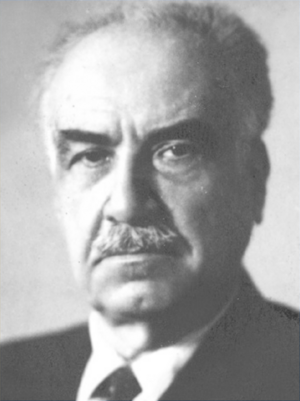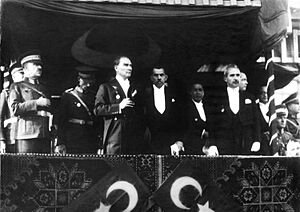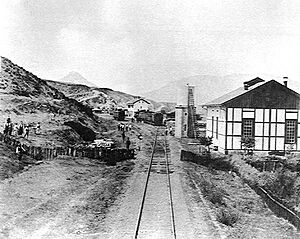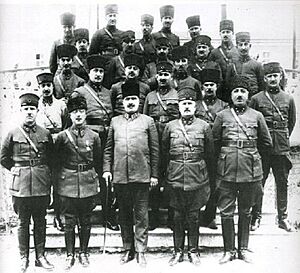Fevzi Çakmak facts for kids
Quick facts for kids
Mareşal
Fevzi Çakmak
|
|
|---|---|

Çakmak in 1946
|
|
| 2nd Prime Minister of the Government of the Grand National Assembly | |
| In office 24 January 1921 – 12 July 1922 |
|
| Preceded by | Mustafa Kemal Atatürk |
| Succeeded by | Rauf Orbay |
| 1st Deputy Prime Minister of Turkey | |
| In office 3 May 1920 – 24 January 1921 |
|
| Prime Minister | Mustafa Kemal Atatürk |
| Preceded by | Position established |
| Succeeded by | Mümtaz Ökmen (1946) |
| 2nd Chief of General Staff | |
| In office 5 August 1921 – 12 January 1944 |
|
| President | Mustafa Kemal Atatürk İsmet İnönü |
| Preceded by | İsmet İnönü |
| Succeeded by | Kâzım Orbay |
| 1st Minister of National Defense | |
| In office 3 May 1920 – 5 August 1921 |
|
| Prime Minister | Mustafa Kemal Atatürk Himself |
| Preceded by | Position established |
| Succeeded by | Refet Bele |
| Minister of War of the Ottoman Empire | |
| In office 3 February 1920 – 2 April 1920 |
|
| Prime Minister | Ali Rıza Pasha Salih Hulusi Pasha |
| 5th Chief of General Staff of the Ottoman Empire | |
| In office 24 December 1918 – 14 May 1919 |
|
| Prime Minister | Ahmet Tevfik Pasha Damat Ferid Pasha |
| Preceded by | Djevad Pasha |
| Succeeded by | Djevad Pasha |
| Personal details | |
| Born | 12 January 1876 Cihangir, Istanbul, Ottoman Empire |
| Died | 10 April 1950 (aged 74) Teşvikiye, Istanbul, Turkey |
| Resting place | Eyüp Cemetery |
| Political party | Nation Party (Turkish Republic, 1948–50) Democrat Party (Turkish Republic, 1946–48) Committee of Union and Progress (Ottoman Empire) |
| Signature | |
| Nicknames | Kavaklı Fevzi, Müşir, Mareşal |
| Military service | |
| Allegiance | |
| Branch/service | |
| Years of service | 1896–1944 |
| Rank | |
| Commands | 2nd Division, 5th Corps, 2nd Caucasian Corps, 2nd Army, 7th Army, 1st Army Troops Inspectorate, Chief of the General Staff |
| Battles/wars | Albanian Uprising Italo-Turkish War Balkan Wars First World War War of Independence Sheikh Said rebellion Ararat rebellion Dersim Rebellion |
Fevzi Çakmak (born January 12, 1876 – died April 10, 1950) was a very important Turkish soldier and politician. He reached the highest military rank, a field marshal (called Mareşal in Turkey). He served as the Chief of General Staff for a long time, from 1921 to 1944. He also held many important government jobs, like being the Minister of War, Deputy Prime Minister, and even Prime Minister of Turkey.
Fevzi Çakmak played a key role in the Turkish War of Independence, helping to lead the fight for Turkey's freedom. He is one of only two people in Turkey's history to become a field marshal, the other being Mustafa Kemal Atatürk.
Contents
Life Story of Fevzi Çakmak
Early Life and Education
Mustafa Fevzi was born on January 12, 1876, in Cihangir, a neighborhood in Istanbul, which was then part of the Ottoman Empire. His family came from Balıkesir. His father, Ali Sırrı Efendi, worked as a secretary for the Arsenal. When Fevzi was young, his family moved to Rumeli Kavağı. Because of this, he later became known in the army as "Kavaklı Fevzi Pasha."
Fevzi went to several schools as a child. He studied at Sadık Hoca Mektebi and Tedrisiye-i Haybiye Mektebi. He also attended military schools like Salonica Military School and Soğukçeşme Askerî Rüşdiyesi. He learned Arabic and Persian from his grandfather, who was a very smart person.
In 1890, he joined Kuleli Military High School. After graduating, he entered the Ottoman Military College in 1893. He finished military school as one of the top students in 1896. He then joined the Ottoman military as a Second Lieutenant and fought in the 1897 Greco-Turkish War. In 1898, he continued his studies at the Imperial War Academy and became a staff captain in 1898.
Serving in Western Rumelia
In 1899, Fevzi became a staff officer in the Third Army, stationed in Metroviça (now Mitrovica). He learned Serbian, Bulgarian, and Albanian languages to understand local newspapers and gather information. He was promoted several times, becoming a Major in 1902 and a Lieutenant Colonel in 1906.
In 1908, he was made governor and commander of Taşlıca (now Pljevlja). He also became the chief of staff for the Kosovo Provisional Corps. He was involved in the Italo-Turkish War in 1911 and worked on plans for reforms in Albania.
Balkan Wars Experience
In 1912, Fevzi Çakmak became the chief of operations for the Vardar Army during the First Balkan War. He saw how the Ottoman forces were spread out, which made them weaker against the enemy. He also noticed that the army lacked enough artillery, wireless communication, and air units.
During the Battle of Monastir in November 1912, his younger brother, Muhtar Efendi, was killed in action. After the defeat, the Vardar Army had to retreat to Albania. Fevzi felt very sad about losing parts of their homeland, which had been under Turkish rule for centuries. He wrote about the "unacceptable heartbreak and nostalgia" of leaving Western Rumelia.
After the war, in 1913, he became the commander of the Ankara Reserve Division and later the 2nd Infantry Division. He was promoted to colonel.
World War I Service
In 1913, Fevzi Çakmak became the commander of the V Corps. His corps played a vital role in defending Gallipoli during the Gallipoli Campaign. In 1915, he was promoted to Mirliva (a military rank). He led his corps in important battles like Achi Baba and Battle of Sari Bair. Sadly, his younger brother, Lieutenant Mehmed Nazif Efendi, was killed during the Battle of Chunuk Bair in August 1915.
Later, he commanded the Anafartalar Group and then the II Caucasian Corps on the Eastern Front. In 1917, he became the commander of the Second Army and later the Seventh Army on the Sinai and Palestine Front. He faced many challenges, including poor communication and supply issues. In 1918, he fell ill and returned to Istanbul for treatment.
After World War I, in December 1918, Fevzi Pasha was appointed Chief of the General Staff of the Ottoman Empire. He worked with other important military leaders to plan the defense of their homeland. He briefly served as the Minister of War in 1920.
Turkish War of Independence
After the Ottoman government resigned, Fevzi Çakmak traveled to Anatolia to join the national movement, arriving in Ankara in April 1920. He was elected as a representative for Kozan and became the Minister of Defense and Vice Prime Minister in the new Government of the Grand National Assembly.
The old Ottoman Military Court sentenced him to death because he joined the national movement, but he continued his work in Ankara.
He played a crucial role in the Turkish War of Independence. He took command of the army after a difficult battle at Kütahya-Altıntaş and managed to stop the army's retreat.
Battle of Sakarya
Before the important Battle of Sakarya, in August 1921, he became the Minister of the Chief of the General Staff. Under his leadership, the Army of Grand National Assembly successfully defeated the Greek forces near Ankara in the Battle of Sakarya. This was a major turning point in the war.
In July 1922, he resigned as Prime Minister.
Great Offensive and Field Marshal Rank
Fevzi Çakmak and Mustafa Kemal together planned and led the Battle of Dumlupınar, which was a huge victory for the Turkish forces. Because of his great success, on August 31, 1922, he was promoted to the rank of Müşir (which means Field Marshal) based on Mustafa Kemal's recommendation.
Fevzi Çakmak and Mustafa Kemal Atatürk are the only two field marshals in the history of the Republic of Turkey. Even today, when people say "Mareşal," they often mean Fevzi Çakmak.
Republican Era

In August 1923, Fevzi Çakmak was elected as a representative from Istanbul. On March 3, 1924, he was appointed as the Chief of the General Staff of the Republic of Turkey. He decided to leave politics and resigned from parliament in October 1924 to focus on his military duties.
Government Policies in the East
In 1925, after a rebellion in the east, Fevzi Çakmak was part of a council that worked on plans for reforms in the eastern regions of Turkey. This council suggested ways to bring stability and development to these areas.
Later Years and Retirement
Fevzi Çakmak was a highly respected war hero. His name was even mentioned as a possible person to become the next President of Turkey after Atatürk's death in 1938. However, he chose not to run and supported İsmet İnönü for the presidency instead.
He continued to serve as Chief of General Staff until January 12, 1944, when he retired. After retiring from the military, he became a Member of Parliament for Istanbul with the Democrat Party. Later, he left that party and helped start the Nation Party.
Death
Fevzi Çakmak passed away on April 10, 1950, at his home in Teşvikiye, Istanbul. His funeral was held at the Beyazıt Mosque, and he was buried in Eyüp Cemetery in Istanbul. His family did not want his body moved to the Turkish State Cemetery in Ankara.
Fevzi Çakmak was a very intelligent person who knew many languages, including French, English, German, Russian, Persian, Arabic, Albanian, and Bosnian. He could speak French well and translated texts from English and German.
Awards and Honors
Fevzi Çakmak received many medals and decorations for his military service, including:
- Imtiyaz Medal in Silver (1900)
- Order of Medjidie, 5th class (1900)
- Order of Osmanieh, 4th class (1906)
- Harp Madalyası (1915)
- Silver (1915)
- Iron Cross, 2nd class (Germany, 1915)
- Gold Liakat Medal (1916)
- War Medal (Germany, 1916)
- İmtiyaz Medal in Gold (1916)
- Military Merit Cross, 2nd class (Austria-Hungary, 1917)
- Order of the Osmanî with Swords, 2nd class (1917)
- Order of the Osmanî with Swords, 1st class (1918)
- Order of the Crown (Württemberg, 1918)
- Medal of Independence with Red-Green Ribbon (1923)
Works
Fevzi Çakmak also wrote books about military history and his experiences:
- Garbî Rumeli'nin Suret-i Ziya-ı ve Balkan Harbinde Garp Cephesi Hakkında. Konferanslar (1927)
- Büyük Harpte Şark Cephesi Hareketleri (1936)
Family Tree
| Kamile (?–1915) |
Limnili Hacı Derviş Hüseyin Kaptan (1782?–1897/98) |
Üzile | Hoca Bekir Efendi (1815–1898) |
Fitnat | |||||||||||||||||||||||||||||||||||||||||||||||||||||||||||||||
| Hasan Vasfi (1858–1927) |
Hacı Rasim (1870–1945) |
Tevfik | Ali Sırrı (1855/6-1914) |
Hesna | Ayşe Şahver | Ali Nuri (1866–1901) |
Emine Eda | ||||||||||||||||||||||||||||||||||||||||||||||||||||||||||||
| Mehmed Nazif (1882 – 8 August 1915 †) |
Muhtar (1884 – 16 November 1912 †) |
Sami (1892–1909) |
Nebahat (1894–1986) |
||||||||||||||||||||||||||||||||||||||||||||||||||||||||||||||||
| MUSTAFA FEVZİ ÇAKMAK ("Mareşal") |
Fatma Fitnat (1891–1969) |
Münir | |||||||||||||||||||||||||||||||||||||||||||||||||||||||||||||||||
| M. Şefik Çakmak (1892–1966) |
Nigar Çakmak (1909–1982) |
A. Muazzez (1911–1939) |
Burhan Toprak (1906–1967) |
||||||||||||||||||||||||||||||||||||||||||||||||||||||||||||||||
| Professor emeritus of Princeton University Ahmet Şefik Çakmak (1934–) |
Noriko Nagafuji Çakmak Ja チャクマク・長藤紀子 (1949–) |
||||||||||||||||||||||||||||||||||||||||||||||||||||||||||||||||||
| Erika Leila (1972–) |
Lisa Ayla (1978–) |
||||||||||||||||||||||||||||||||||||||||||||||||||||||||||||||||||
See also
- List of high-ranking commanders of the Turkish War of Independence







